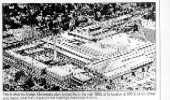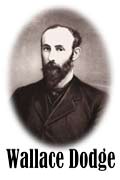Top of Site > Company Information > Company Histories > Dodge Manufacturing
![]()
![]()
Table of Contents
My historical information is provided by Ed Wallis, an avid historian, now retired from Dodge Manufacturing Company after 40 years. Any errors in the re-telling are mine. (Note: the Dodge Manufacturing Company has no relation to the car manufacturer.)
Principal sources are Indiana's Princess City,
1832-1932 by Janice Bridges, The Heritage Press 1976,
and the 1905 issue of Power and Transmission.
 This sketch shows the
original factory and sawmill of 1878.
This sketch shows the
original factory and sawmill of 1878.
 This photo
shows the west frontage of the factory in 1905. Compare the
tower in the aerial view below, taken in the mid'60s.
This photo
shows the west frontage of the factory in 1905. Compare the
tower in the aerial view below, taken in the mid'60s.
 Large size versions are available,
using links below.
Large size versions are available,
using links below.
Picture and description of plant in 1878
The embryo of the firm in June of 1878 was a little
sawmill property. The Magic
wagon jack was patented in 1878; half a
million were sold, at 12$ a dozen. A natural extension of the
business required the addition of a turning lathe, and other
simple tools, to make such wooden hardware as: window
screens, door stops, tool handles, saw frames, bench clamps,
vise handles, mallets, and other such items.
In 1880, the firm was incorporated with $50, 000 capital, as the Dodge Manufacturing Co, with Wallace H Dodge, his brother, William W Dodge, his mother Elizabeth, and George Phillion as principal stockholders. It continued to grow and prosper, until a fire in June of 1881 totally destroyed the factory.
Rebuilding began at once on a larger and more substantial plan. Tradition says that iron pulleys were unavailable for the new factory. Dodge initially developed a wood split pulley for internal use. When neighboring manufacturers were impressed and asked for pulleys for themselves, the decision was made to market the pulleys commercially.
On the Fourth of July of 1882, the Independence
wood split pulley was patented, the joint invention of George
Phillion and Wallace Dodge. (The name was chosen because of
the date of the patent.) It revolutionized the pulley
business from one of making units to order to one of selling
stock merchandise. In 1884, a two story brick building was
erected, to handle increased demands.
This was the Steam Age, with leather belts and manila or cotton ropes distributing power from a central overhead shaft to individual machines. These were known as English System drives.
Dodge sought a better drive. In 1887, the Dodge System of Rope Drives was patented by Dodge and his engineer W. B. Hosford, and in 1893, it was demonstrated at the power plant of the World's Columbian Exhibition in Chicago. These were known as the Dodge or American System.
There was a complete line of power transmission specialties, with wood pulleys, rope drives, and cast iron gears; the wooden hardware business lingered only in memory. We can surmise that clamp making had ceased by this time, possibly much sooner.
Dodge died in 1894, and was succeeded by Melville W Mix (aged 27), the son of his sister, Mrs. Walter Mix. Melville was considered one of the master salesmen on his time. He saw the need to produce a standard line of units, with nation-wide distribution centers.
Picture and description of plant in 1905
In 1905, the sawmill continued, merely one minor part of the manufacturing system, but much larger than the original mill. By this time, the firm became much more focused on power transmission. It had won numerous awards from the Franklin Institute, the World's Fairs of Chicago and St. Louis, and the Pan American Exposition, among others, for its wood pulleys (1885 through 1891, and 1901), Power Transmission Machinery (1891 through 1904), and related equipment. These bronze, silver, and gold medals were featured in its advertisements.
The company contributed to the war effort in WW I, and in
WW II, receiving the Army-Navy E
award.
Picture and description of plant in 1965
In 1967 Dodge merged with Reliance Electric company. In 1977, a national distribution center opened in Kentucky, and a gear plant in South Carolina. In 1979, Reliance was acquired as subsidiary of Exxon Corporation. In 1982, portions of the Dodge operations were relocated to Indiana, Tennessee, and the Carolinas.
In 1995, Reliance was acquired by Rockwell International, in a transaction valued at 1.6 billion dollars. In 1996, at the Mishawaka plant, there is a 200 tons/ day foundry, machine shop, and fabricating shop, the largest producer of conveyor systems in the US. Employment levels approach 700.
 Wallace Harlow
Dodge was born on 10 July 1849 in Mishawaka. He had a
brother, William, and two sisters. At the age of 19, he
completed his studies at Notre Dame. He showed his mechanical
ingenuity in his father's hardware and tinsmithing shop.
Wallace Harlow
Dodge was born on 10 July 1849 in Mishawaka. He had a
brother, William, and two sisters. At the age of 19, he
completed his studies at Notre Dame. He showed his mechanical
ingenuity in his father's hardware and tinsmithing shop.
He married Hattie Veasey of Sturgis, Michigan, on 13 July 1870. They had no children.
In 1878, at the age of 29, he opened his factory. (See above, for its history.)
He looked upon municipal affairs with a broad minded view. Mishawaka's Water Works system, Electric Light, a hotel, and public library was due, in great measure, to his advice and energy.
In 1894, Wallace H Dodge died, aged 45. His funeral
services were in accordance with the Knights Templar ritual,
of which [he] was an honored member.
As a widow, Mrs
Dodge purchased a Queen Anne style home built in 1889, and
continued to live in Mishawaka until her death in 1922.
Ed Wallis was born and raised in Mishawaka. He completed course work at Acme School of Tool and Die Design, and began work at Dodge as a tool designer in 1943. From tool design, he moved up to Development Engineering, and worked with Jackson Chung, who developed the Dodge Torque-Arm Speed Reducer.
After more than 25 years, he became a Publications Specialist in advertising. He studied technical writing at Ivy Tech, and wrote copy for industrial distributors, and Dodge sales people, for fourteen years.
He stayed with Dodge for forty years, to 1983.
In his retirement, he writes for the South Bend Tribune, and other local newspapers; he is actively involved in the local historical society.
last revised and validated
Copyright © 1996- Wooden Clamp Journal